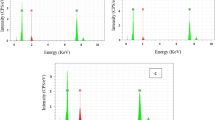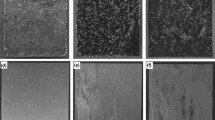Abstract
The type 304 stainless steel will be widely applied as one of the substrate materials of the flexible displays. In this paper, many experiments using chemical mechanical polishing (CMP) slurry with the FeCl3 oxidant at different pH values were studied in the material removal rate (MRR) and the surface roughness. Chemical action mechanisms about the Fe3+, the H+, the OH− and the Cl− in the CMP slurry was also studied in the CMP of 304 stainless steel. These research results show that the ion Fe3+ can react with the iron, the nickel and the chromium in the 304 stainless steel to produce the ferrous chloride. The ion Cl− can react with metal ions, such as the Fe2+, the Fe3+ and the Ni2+ to form a soluble complex ion and improve the MRR. The higher the concentration of the ion H+ in the CMP slurry is, the stronger the etching effect of the ion H+ on the 304 stainless steel will be. It can inhibit the hydrolysis of the FeCl3 to form the Fe(OH)3 precipitation, and increase the concentration of the Fe3+ in the CMP slurry and the MRR. The ion OH− in the CMP slurry can react with the Fe3+ to form the Fe(OH)3, which reduced the concentration of the Fe3+ in the CMP slurry and the MRR






Similar content being viewed by others
References
T. Hanada, T. Negishi, I. Shiroishi et al., Plastic substrate with gas barrier layer and transparent conductive oxide thin film for flexible displays. Thin Solid Films 518(11), 3089–3092 (2010)
W.J. Wu, J.W. Chen, J.S. Wang et al., High-resolution flexible AMOLED display integrating gate driver by metal-oxide TFTs. IEEE Electron Dev. Lett. 39(11), 1660–1663 (2018)
W. Hwang Han, S.H. Hong, S.S. Hwang et al., Analysis of recoverable residual image characteristics of flexible organic light-emitting diode displays using polyimide substrates. IEEE Electron Dev. Lett. 40(7), 108–1111 (2019)
A. Sugimoto, H. Ochi, S. Fujimure et al., Flexible OLED displays using plastic substrates. IEEE J Sel Top Quantum Electron 10(1), 107–114 (2004)
S.H. Lee, J.H. Han, S.H. Lee et al., Review of organic/inorganic thin film encapsulation by atomic layer deposition for a flexible OLED display. J. Metals 71(1), 197–211 (2019)
K. Hong, H.K. Yu, I. Lee et al., Flexible top-emitting organic light emitting diodes with a functional dielectric reflector on a metal foil substrate. RSC Adv. 8(46), 26156–26160 (2018)
A. Latifi, M. Imani, M.T. Khorasani et al., Electrochemical and chemical methods for improving surface characteristics of 316L stainless steel for biomedical applications. Surf. Coat. Technol. 221(4), 1–12 (2013)
J.X. Su, Y.A. Peng, Z.H. Liu et al., Study on the pH Value regulator of Ferric Chloride based slurry in chemical mechanical polishing 304 stainless steel. UPB Scienti. Bulet. Ser. B 79(2), 179–190 (2017)
D. Lee, H.J. Kim, B.J. Pak et al., Electrochemical analysis of the slurry composition for chemical mechanical polishing of flexible stainless-steel substrates. J. Frict. Wear 38(6), 482–489 (2017)
X.K. Hu, Z.T. Song, Q. Fei et al., Chemical mechanical polishing of stainless steel foil as flexible substrate. Appl. Surf. Sci. 258(15), 5798–5802 (2012)
X.D. Yang, X. Wei, X.Z. Xie et al., An analysis of kinematic mechanism on ultra-thin stainless steel substrate in chemical mechanical polishing. Modul. Mach. Tool Autom. Manuf. Tech. 5, 27–30 (2015)
Q. Zhang, Y.W. Zhao, Research of the Influence of Process Parameters on the Polishing Speed and Polishing Quality of Stainless Steel. J. Jiangnan Univ. (Nat. Sci. Ed.) 14(3), 321–325 (2015)
Q.S. Wang, H. Guan, Y. Zhang, Electrochemical study of corrosion behavior of 304 stainless steel in FeCl3 solution. J. Shenyang Univ. (Nat. Sci.) 30(5), 350–355 (2018)
Z.J. Jia, C.W. Du, X.G. Li, Detection of pitting corrosion of 316L stainless steel in FeCI3 solution by electrochemical noise. Corros. Prot. 32(7), 497–502 (2011)
Z.Z. Zhang, J.M. Gong, H. Liang, Research on acoustic emission monitoring of pitting corrosion on 304 stainless steel. Chin. J. Acoust. 32(1), 70–78 (2013)
J.Q. Zhao, H.S. Bao, G. Yang, Pitting corrosion behavior of 0Crl3 Ferritic Stainless Steel in FeCl Solution. Corros. Prot. 38(6), 420–424 (2017)
Y.H. Huang, F.Z. Xuan, S.T. Tu, Study on stress corrosion property of 304 austenitic stainless steel in the environment of acid chloride solution. Press. Vessel Technol. 26(7), 5–10 (2009)
P. Liu, Y.G. Du, W.J. Zhang et al., Influence factors on etching rates of iron nickel alloy foils in ferric chloride solution. Corros. Prot. 28(5), 238–241 (2007)
J.X. Su, J.J. Li, Z.K. Wang et al., Chemical action in CMP 304 stainless steel based on hydrogen peroxide slurry. Acta Tech. 62(4B), 1–12 (2017)
B. Lin, Surface treatment of stainless steels: acid pickling passivation and polishing. Dev. Appl. Mater. 21(3), 36–39 (2006)
E. Tcharkhtchi-Gillard, M. Benoit, P. Clavier et al., Kinetics of the oxidation of stainless steel in hot and concentrated nitric acid in the passive and transpassive domains. Corros. Sci. 107(1), 182–192 (2016)
X.Y. Zhao, Chemical cleaning of austenitic stainless steel and passivation. Clean. World 23(5), 16–19 (2007)
C.Y. Yu, Technology for acid cleaning and passivation of stainless steel equipment and parts. Clean. World 20(1), 20–24 (2004)
W.B. Zou, X. Wei, X.D. Yang et al., Research on chemical polishing method for stainless steel substrate. Mach. Des. Manuf. 1, 258–260 (2013)
P. Tyagi, T. Goulet, C. Riso et al., Reducing surface roughness by chemical polishing of additively manufactured 3D printed 316 stainless steel components. Int. J. Adv. Manuf. Technol. 100(9–12), 2895–2900 (2019)
T.Y. Chen, Surface Treatment Technology of Stainless Steel (Chemical Industry Press, Beijing, 2004), pp. 374–380
Z. Fang, L. Zhang, Y.S. Wu, Mechanism of SCC of austenitic 304SS in HCI–NaCI solution room temperature. Corros. Sci. Prot. Tech. 7(1), 42–47 (1995)
H. Xia, D. Zhou, Y. Ding et al., Study on the pickling and passivation of environmental protection and the performance of 304 stainless steel. Surf. Technol. 8(4), 47–49 (2009)
Acknowledgements
Supported by the National Natural Science Foundation of China (No.U1804142) and the Science and Technology Research Project of Henan Province (No.192102210058).
Author information
Authors and Affiliations
Corresponding author
Additional information
Publisher's Note
Springer Nature remains neutral with regard to jurisdictional claims in published maps and institutional affiliations.
Rights and permissions
About this article
Cite this article
Su, J., Wang, Y., Wang, Z. et al. Study on Chemical Action Mechanism of Ferric Chloride-Based Polishing Slurry in CMP of 304 Stainless Steel. J. Inst. Eng. India Ser. E 102, 175–182 (2021). https://doi.org/10.1007/s40034-021-00214-4
Received:
Accepted:
Published:
Issue Date:
DOI: https://doi.org/10.1007/s40034-021-00214-4




